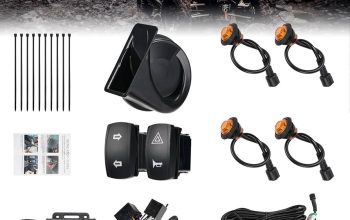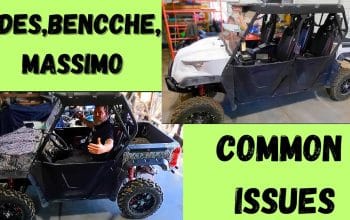Yamaha Rhino 450 users often report engine overheating and transmission issues. Electrical problems and poor suspension performance are also common.
The Yamaha Rhino 450, a popular UTV, has gained attention for its versatility and durability. Despite its many strengths, owners frequently encounter specific problems. Engine overheating is a significant issue, often caused by inadequate cooling systems. Transmission problems, such as difficulty shifting gears, also plague users.
Electrical issues, including faulty wiring and battery drainage, can disrupt rides. The suspension system sometimes fails to provide a smooth experience, leading to uncomfortable rides on rough terrain. Regular maintenance and prompt attention to these issues can enhance the vehicle’s performance and longevity. Understanding these common problems helps owners take proactive measures to ensure their Yamaha Rhino 450 runs efficiently.
Engine Troubles
The Yamaha Rhino 450 is a reliable UTV, but it has engine issues. These problems can affect your ride and cause frustration. Let’s explore some common engine troubles.
Starting Issues
One common problem is starting the engine. The engine might not start on the first try. This can be due to a weak battery or bad spark plugs.
Here are some reasons your engine might not start:
- Weak battery
- Faulty spark plugs
- Clogged fuel filter
Make sure to check these components regularly. Regular maintenance can help avoid these issues.
Overheating Concerns
Another issue is engine overheating. Overheating can cause serious damage. It can lead to costly repairs.
Here are some signs of an overheating engine:
- High temperature gauge reading
- Steam from the engine
- Loss of power
To prevent overheating, keep the radiator clean. Ensure the coolant levels are adequate. Check the fan for proper operation.
Use this table to quickly identify common engine problems and solutions:
| Problem | Possible Cause | Solution |
|---|---|---|
| Engine won’t start | Weak battery | Charge or replace battery |
| Engine won’t start | Faulty spark plugs | Replace spark plugs |
| Engine overheating | Low coolant | Refill coolant |
| Engine overheating | Dirty radiator | Clean radiator |
Transmission Problems
Transmission problems in the Yamaha Rhino 450 can be frustrating. They often affect the vehicle’s performance and reliability. In this section, we discuss common transmission issues.
Gear Shifting Difficulties
Many Yamaha Rhino 450 owners report gear shifting difficulties. This issue occurs when shifting gears becomes hard or impossible. There are several causes for this problem:
- Worn-out clutch – The clutch may need replacement.
- Damaged gears – Internal gears can wear out over time.
- Improper lubrication – Insufficient lubrication can cause friction.
These causes can significantly impact the riding experience. Regular maintenance and timely repairs help mitigate these issues.
Unusual Noises
Unusual noises from the transmission are another common problem. These noises can indicate underlying issues:
- Grinding sounds – Often suggest worn or damaged gears.
- Clunking noises – Can result from loose components.
- Whining sounds – Typically point to bearing problems.
Detecting these noises early can prevent further damage. Addressing them promptly ensures the longevity of the transmission system.
Electrical System Faults
The Yamaha Rhino 450 is a robust utility vehicle. Yet, it has its share of electrical system faults. These issues can affect its overall performance. Let’s dive into some common electrical problems.
Battery Drain
One major issue is battery drain. Owners often find their Rhino’s battery depleting too fast. This can be frustrating, especially in remote areas.
- Check for any parasitic draws.
- Ensure all lights are off when not in use.
- Inspect the battery’s health regularly.
Using a battery tender can help maintain charge. It’s a simple, cost-effective solution.
Faulty Wiring
Another common problem is faulty wiring. Wiring issues can lead to various malfunctions. These include starting problems and lighting failures.
| Symptom | Possible Cause | Solution |
|---|---|---|
| Engine won’t start | Loose connections | Tighten all wiring connections |
| Lights flicker | Damaged wires | Replace damaged wires |
| Battery not charging | Corroded terminals | Clean terminals |
Regular inspection of the wiring harness is essential. This helps identify potential problems early.
Brake System Issues
The Yamaha Rhino 450 is a popular off-road vehicle. Brake system issues can affect its performance and safety. Below, we discuss two common brake problems: Brake Fade and Squeaky Brakes.
Brake Fade
Brake fade occurs when the brakes overheat. This can make the brakes less effective. Here are some signs of brake fade:
- Longer stopping distances
- Soft brake pedal
- Burning smell
Causes of brake fade include:
- Frequent braking on steep hills
- Carrying heavy loads
- Worn-out brake pads
To prevent brake fade, regularly inspect the brake system. Replace worn-out parts promptly. Avoid excessive braking, especially on steep terrain.
Squeaky Brakes
Squeaky brakes are a common issue with the Yamaha Rhino 450. They can be annoying and indicate a problem. Here are some reasons for squeaky brakes:
- Dust and dirt on the brake pads
- Worn-out brake pads
- Glazed brake pads or rotors
To fix squeaky brakes, start with a thorough cleaning. Use a brake cleaner to remove dust and dirt. If the noise persists, check the brake pads. Replace them if they are worn or glazed. Sometimes, applying anti-squeal lubricant can help.
Regular maintenance of the brake system is crucial. This ensures the safety and performance of your Yamaha Rhino 450. Addressing brake issues early can prevent more serious problems down the road.
Suspension Woes
The Yamaha Rhino 450 has a rugged build. But its suspension can cause headaches. Riders often report issues that affect performance and comfort. Let’s dive into the common suspension problems faced by Yamaha Rhino 450 owners.
Uneven Ride
An uneven ride is a frequent issue. This makes driving less enjoyable. Causes include:
- Misaligned wheels
- Worn-out suspension components
- Imbalanced tires
Misaligned wheels can cause the vehicle to pull to one side. This affects handling and safety. Regular wheel alignment checks are essential.
Worn-out suspension components like bushings and control arms can lead to an uneven ride. These parts should be inspected and replaced if necessary.
Imbalanced tires can cause vibrations and an uneven ride. Ensure tires are balanced regularly. This simple step can improve ride quality.
Shock Absorber Failures
Shock absorbers play a key role in ride comfort. Failures in these components can cause significant issues. Symptoms of failing shock absorbers include:
- Excessive bouncing
- Leaking fluid
- Poor handling
Excessive bouncing indicates worn-out shock absorbers. The vehicle may bounce too much after hitting a bump. This affects both comfort and control.
Leaking fluid is another sign of shock absorber problems. Fluid leaks reduce the effectiveness of the shocks. Regularly check for leaks to prevent this issue.
Poor handling can result from faulty shock absorbers. The vehicle may feel unstable during turns. Replacing faulty shocks can restore proper handling.
Fuel System Complications
The Yamaha Rhino 450 is a popular all-terrain vehicle. Yet, many owners encounter fuel system complications. These issues can hinder performance and cause frustration. Let’s dive into some common fuel system problems.
Fuel Line Blockages
One common issue is fuel line blockages. Dirt and debris can clog the fuel lines. This restricts the flow of fuel to the engine. Here are some symptoms of fuel line blockages:
- Engine sputtering
- Inconsistent acceleration
- Difficulty starting the vehicle
Regular maintenance can prevent these issues. Always check and clean the fuel lines. Replace them if necessary. Keeping the fuel lines clear ensures smooth performance.
Fuel Pump Malfunctions
Fuel pump malfunctions are another frequent problem. The fuel pump delivers fuel to the engine. A malfunctioning pump can lead to several issues:
- Engine stalling
- Reduced power
- Increased fuel consumption
Check the fuel pump regularly. Listen for unusual noises. If the pump makes a whining sound, it may be failing. Replacing a faulty fuel pump can restore vehicle performance.
To summarize, the fuel system is critical for the Yamaha Rhino 450. Regular checks and maintenance can prevent blockages and pump malfunctions. Stay vigilant to keep your vehicle running smoothly.
Cooling System Challenges
The Yamaha Rhino 450 is a reliable off-road vehicle. Yet, it can face cooling system challenges. These issues can lead to overheating and engine damage. Addressing these problems promptly is crucial to ensure optimal performance.
Radiator Leaks
Radiator leaks are a common problem in the Yamaha Rhino 450. These leaks can occur due to several reasons:
- Damaged radiator fins from debris or off-road impacts.
- Corroded radiator from prolonged use or improper maintenance.
- Loose radiator hoses causing coolant to escape.
Regularly inspect the radiator for any signs of damage or leaks. Replace damaged components immediately to prevent overheating.
Coolant Flow Problems
Coolant flow problems can significantly affect the Rhino 450’s performance. Common issues include:
- Clogged coolant passages due to dirt or debris.
- Faulty water pump failing to circulate coolant properly.
- Air trapped in the cooling system, causing blockages.
To ensure smooth coolant flow:
- Regularly flush the cooling system to remove debris.
- Check and replace the water pump if necessary.
- Bleed the system to remove trapped air.
Proper maintenance can prevent these common issues. Keep your Yamaha Rhino 450 running smoothly on all terrains.
Steering Difficulties
The Yamaha Rhino 450 is a popular utility vehicle. However, some owners report steering difficulties. These issues can affect the vehicle’s performance and safety. Let’s explore some common steering problems and how they impact your ride.
Stiff Steering
One common issue with the Yamaha Rhino 450 is stiff steering. This can make the vehicle hard to maneuver. Stiff steering often results from a lack of lubrication. Regular maintenance can help prevent this problem. Use the right grease for your vehicle’s joints and bearings.
Another cause is worn-out steering components. Check the tie rods and ball joints. Replace any parts that show signs of wear. This will improve your vehicle’s steering response.
Alignment Issues
Alignment issues can also cause steering difficulties. Misaligned wheels can lead to uneven tire wear. This can affect your vehicle’s handling. To check for alignment problems, look at your tires. Uneven wear indicates a need for realignment.
Alignment issues can also make the vehicle pull to one side. This can be dangerous, especially at high speeds. A professional alignment service can fix this problem. Regularly check your alignment to ensure a smooth ride.
Here is a table showing common causes and solutions for steering difficulties:
| Problem | Cause | Solution |
|---|---|---|
| Stiff Steering | Lack of lubrication | Regular maintenance |
| Stiff Steering | Worn-out components | Replace parts |
| Alignment Issues | Misaligned wheels | Professional alignment service |
| Alignment Issues | Uneven tire wear | Check and correct alignment |
Regular checks and maintenance can prevent most steering issues. Ensure your Yamaha Rhino 450 remains in top condition.
Frequently Asked Questions
Why Was The Yamaha Rhino Discontinued?
The Yamaha Rhino was discontinued due to safety concerns and legal issues. Several accidents led to lawsuits, prompting Yamaha to halt production.
What Engine Is In The Yamaha Rhino 450?
The Yamaha Rhino 450 features a 421cc, liquid-cooled, single-cylinder, four-stroke engine. This engine delivers reliable performance for various terrains.
What Is Yamaha Rhino Top Speed?
The Yamaha Rhino’s top speed is approximately 42-45 mph. This speed can vary slightly based on terrain and load.
When Was The Last Yamaha Rhino Made?
The last Yamaha Rhino was made in 2013. Yamaha discontinued the Rhino to focus on newer side-by-side models.
Conclusion
Addressing Yamaha Rhino 450 problems early ensures a smoother ride. Regular maintenance and timely repairs can prevent many issues. Stay informed about common problems and solutions. This proactive approach will enhance your off-roading experience. Remember, a well-maintained Rhino 450 provides reliability and enjoyment for years to come.


